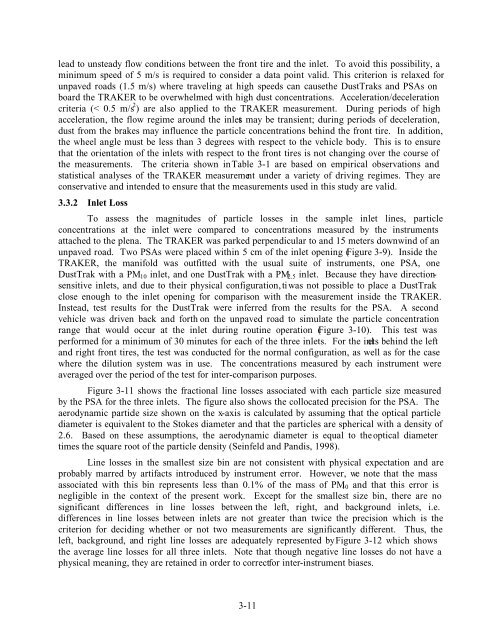treasure valley road dust study: final report - ResearchGate
treasure valley road dust study: final report - ResearchGate
treasure valley road dust study: final report - ResearchGate
You also want an ePaper? Increase the reach of your titles
YUMPU automatically turns print PDFs into web optimized ePapers that Google loves.
lead to unsteady flow conditions between the front tire and the inlet. To avoid this possibility, a<br />
minimum speed of 5 m/s is required to consider a data point valid. This criterion is relaxed for<br />
unpaved <strong>road</strong>s (1.5 m/s) where traveling at high speeds can causethe DustTraks and PSAs on<br />
board the TRAKER to be overwhelmed with high <strong>dust</strong> concentrations. Acceleration/deceleration<br />
criteria (< 0.5 m/s 2 ) are also applied to the TRAKER measurement. During periods of high<br />
acceleration, the flow regime around the inlets may be transient; during periods of deceleration,<br />
<strong>dust</strong> from the brakes may influence the particle concentrations behind the front tire. In addition,<br />
the wheel angle must be less than 3 degrees with respect to the vehicle body. This is to ensure<br />
that the orientation of the inlets with respect to the front tires is not changing over the course of<br />
the measurements. The criteria shown in Table 3-1 are based on empirical observations and<br />
statistical analyses of the TRAKER measurement under a variety of driving regimes. They are<br />
conservative and intended to ensure that the measurements used in this <strong>study</strong> are valid.<br />
3.3.2 Inlet Loss<br />
To assess the magnitudes of particle losses in the sample inlet lines, particle<br />
concentrations at the inlet were compared to concentrations measured by the instruments<br />
attached to the plena. The TRAKER was parked perpendicular to and 15 meters downwind of an<br />
unpaved <strong>road</strong>. Two PSAs were placed within 5 cm of the inlet opening (Figure 3-9). Inside the<br />
TRAKER, the manifold was outfitted with the usual suite of instruments, one PSA, one<br />
DustTrak with a PM 10 inlet, and one DustTrak with a PM 2.5 inlet. Because they have directionsensitive<br />
inlets, and due to their physical configuration, t iwas not possible to place a DustTrak<br />
close enough to the inlet opening for comparison with the measurement inside the TRAKER.<br />
Instead, test results for the DustTrak were inferred from the results for the PSA. A second<br />
vehicle was driven back and forth on the unpaved <strong>road</strong> to simulate the particle concentration<br />
range that would occur at the inlet during routine operation (Figure 3-10). This test was<br />
performed for a minimum of 30 minutes for each of the three inlets. For the inl ets behind the left<br />
and right front tires, the test was conducted for the normal configuration, as well as for the case<br />
where the dilution system was in use. The concentrations measured by each instrument were<br />
averaged over the period of the test for inter-comparison purposes.<br />
Figure 3-11 shows the fractional line losses associated with each particle size measured<br />
by the PSA for the three inlets. The figure also shows the collocated precision for the PSA. The<br />
aerodynamic particle size shown on the x-axis is calculated by assuming that the optical particle<br />
diameter is equivalent to the Stokes diameter and that the particles are spherical with a density of<br />
2.6. Based on these assumptions, the aerodynamic diameter is equal to the optical diameter<br />
times the square root of the particle density (Seinfeld and Pandis, 1998).<br />
Line losses in the smallest size bin are not consistent with physical expectation and are<br />
probably marred by artifacts introduced by instrument error. However, we note that the mass<br />
associated with this bin represents less than 0.1% of the mass of PM 10 and that this error is<br />
negligible in the context of the present work. Except for the smallest size bin, there are no<br />
significant differences in line losses between the left, right, and background inlets, i.e.<br />
differences in line losses between inlets are not greater than twice the precision which is the<br />
criterion for deciding whether or not two measurements are significantly different. Thus, the<br />
left, background, and right line losses are adequately represented by Figure 3-12 which shows<br />
the average line losses for all three inlets. Note that though negative line losses do not have a<br />
physical meaning, they are retained in order to correct for inter-instrument biases.<br />
3-11
















